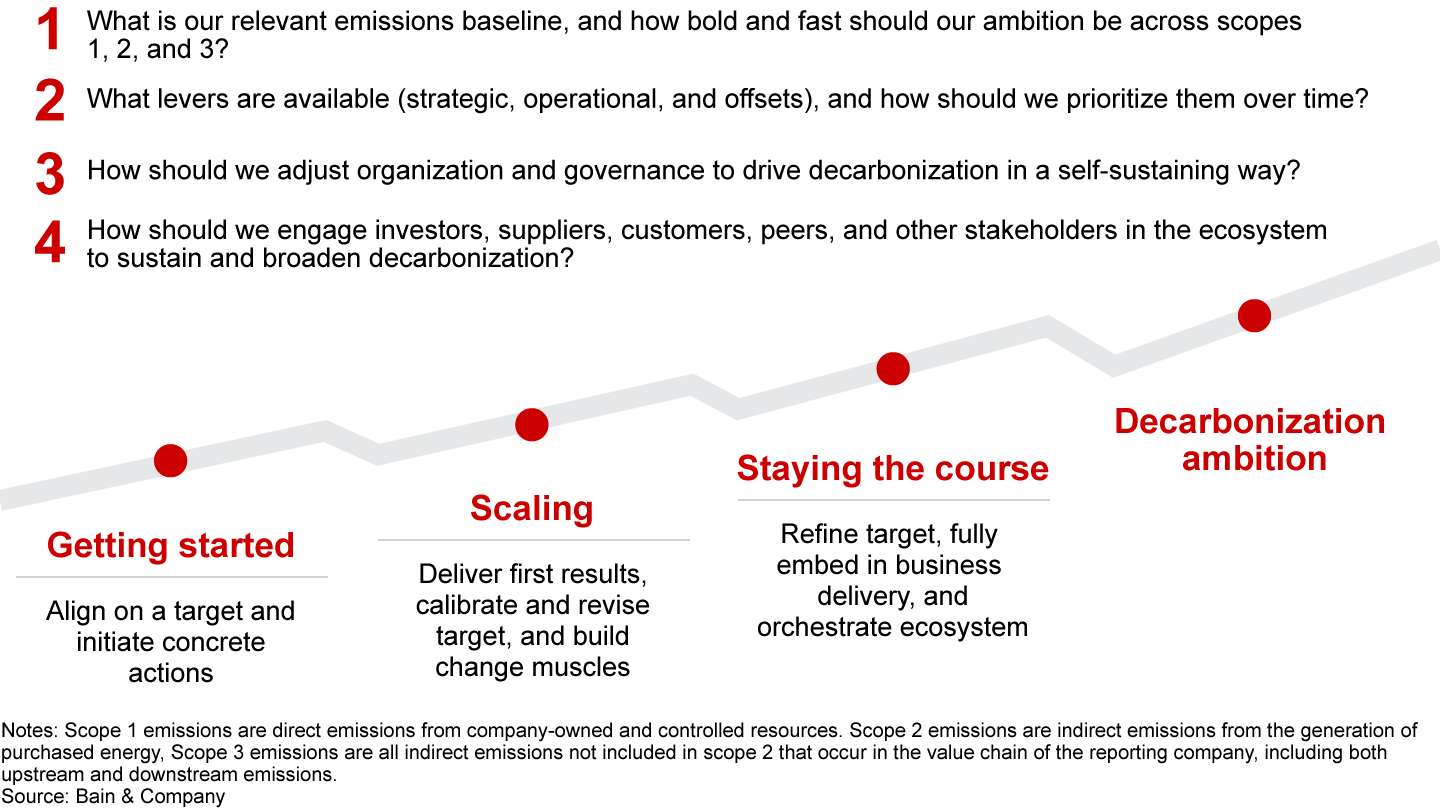Brief

At a Glance
- With consumers, governments, and investors all pushing for decarbonization, companies are racing to act or accelerating their journey.
- In addition to defensive moves like preparing for reporting requirements or anticipating shareholder expectations, leaders are taking proactive steps to create new value.
- Four fundamental questions can guide companies toward a strategic, pragmatic, and self-sustaining approach, wherever they are in their carbon transition.
The carbon transition is accelerating, and every company needs to play a role.
Covid-19 has intensified the race to battle climate change, renewing focus on such critical efforts as drastically cutting greenhouse gas emissions to reach the generally accepted targets of a 50% reduction by 2030 and net zero by 2050. Governments and international organizations are increasing their ambitions, with China committing to carbon neutrality by 2060 and the European Union proposing to raise its target from 40% to 55% reduction by 2030. The United States has pledged to cut emissions at least in half by 2030.
Investors and capital are turning toward green investments. The Transition Pathway Initiative benchmark, which assesses companies’ preparedness for the low-carbon transition as well as their targets against the Paris Agreement, is supported by 104 investors globally, representing more than $26 trillion in combined assets under management and advice. Private equity firms are actively setting carbon reduction targets. And consumers are becoming aware and demanding action—with companies responding.
A single example: Beyond Meat recently formed a joint venture with PepsiCo to develop and sell snacks and beverages made from plant-based protein. Animal agriculture is responsible for 14.5% of global greenhouse gas emissions, according to the United Nations’ Food and Agriculture Organization, with 65% of those emissions coming from beef and dairy cattle.
Two guiding principles for decarbonization
The companies leading the carbon transition follow two guiding principles. They simultaneously play defense and offense, and they view decarbonization as a way to accelerate a full-potential transformation.
Many companies begin their carbon efforts as a way of defending themselves, often by preparing for reporting requirements or anticipating shareholder expectations. They also consider how they will mitigate potential physical risks. Mining companies, for instance, need to anticipate how water scarcity, flooding, and rising temperatures linked to climate change will hurt productivity. Playing defense also means preparing for the issue of stranded assets.
However, carbon transition represents as much upside opportunity as downside risk. Companies are playing offense by taking proactive steps to create new value. Take Bosch, for example. Beyond achieving carbon neutrality itself, the company is developing new products and services to help other companies decarbonize.
Embracing the need for a full strategy overhaul is the second guiding principle. When Bain & Company surveyed 80 business leaders in oil and gas, utilities, new energy, chemicals, agribusiness, mining and minerals services, and financial markets, 60% said that an energy or resource transition was central to the future of their sector, and 35% are starting to change their priorities and create opportunities. Those leaders acknowledge that the climate imperative requires a full-potential transformation that touches every part of the organization.
Companies pursue three types of transformations. Some, like Unilever, have evolved their core business toward sustainability. Others have added a second core. Consider how Finland’s Neste has gone from a traditional oil-driven company to the world’s biggest producer of renewable diesel, dropping the word “oil” from its name in the process. And others have changed their core entirely. Denmark’s Ørsted used the carbon challenge as an opportunity to develop a market for offshore wind.
Regardless of how far along they are in the carbon transition journey, companies typically answer four big questions (see Figure 1).

1. How bold and fast should our ambition be? Leading companies are clear about their decision when it comes to the basic trade-off between speed and boldness. Blackstone opted for speed by aiming to reduce emissions by 15%, within three years of ownership, at all new portfolio companies where it can control energy usage. Shell chose boldness by setting a target of becoming a net-zero-emissions energy business by 2050.
2. What are the available levers? In pursuing a carbon transition, companies have three sets of levers to deploy: strategic, operational, and offsets. Ørsted used its strategic lever by shifting away from fossil fuels. (A significant portion of such moves can actually be ROI positive, even without a price on carbon.) Microsoft has led the way in developing the voluntary carbon market and associated offsets, pledging to remove all of the carbon it has emitted since its founding in 1975 by 2050. In addition, the company launched a $1 billion climate innovation fund to accelerate the global development of carbon reduction, capture, and removal technologies.
3. How should we adjust the organization? The price of carbon is a major consideration in capital allocation, with carbon reduction an important factor in operational improvements, manufacturing decisions, and R&D, among other areas. Companies integrate decarbonization into procurement choices and incentives and then communicate these efforts to customers as part of the new value proposition.
4. How do we engage stakeholders? More than any other transformation, decarbonization draws on a company’s ability to assemble and collaborate with an ecosystem of investors, suppliers, governments, NGOs, peers, and other stakeholders. Companies need to learn how to create dialogues with organizations beyond their own walls and seek productive partnerships. For example, Wind Denmark and Hydrogen Denmark, broad-based organizations that support those power alternatives, have formed an alliance to promote the use of renewable energy–powered electrolysis.
In summary, achieving net zero requires companies to identify opportunities to create value through cost reduction or growth, in addition to risk protection. That means prioritizing areas for deployment based on ROI and external requirements and linking the sustainability agenda to business metrics. It is a multiyear journey, and the best companies boost their odds of success by building change muscles in the organization for the long and important ride.
